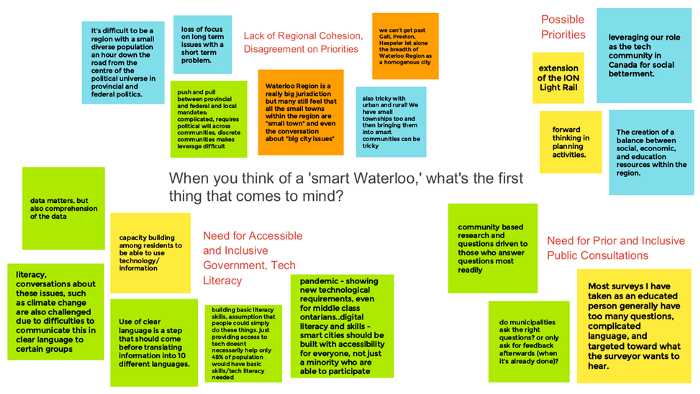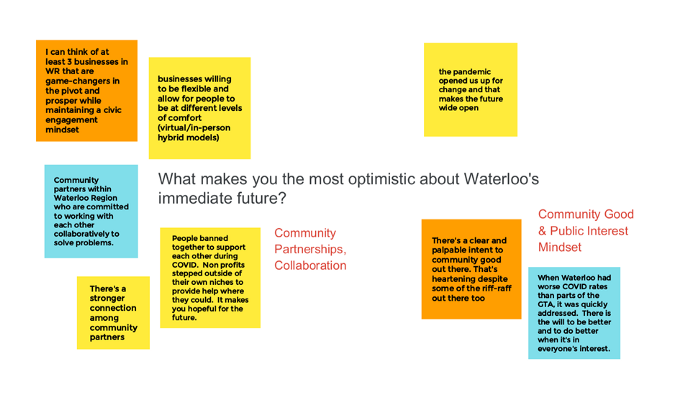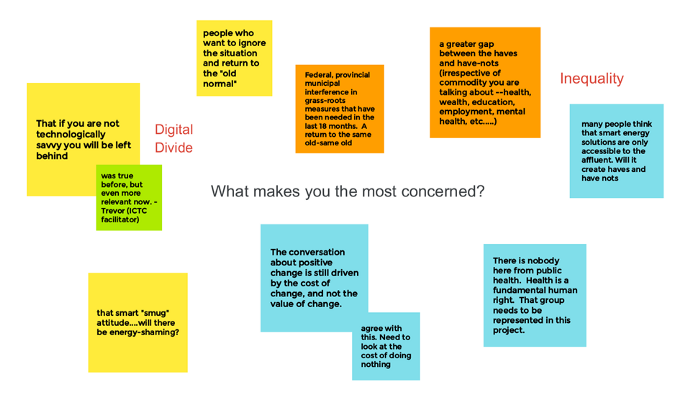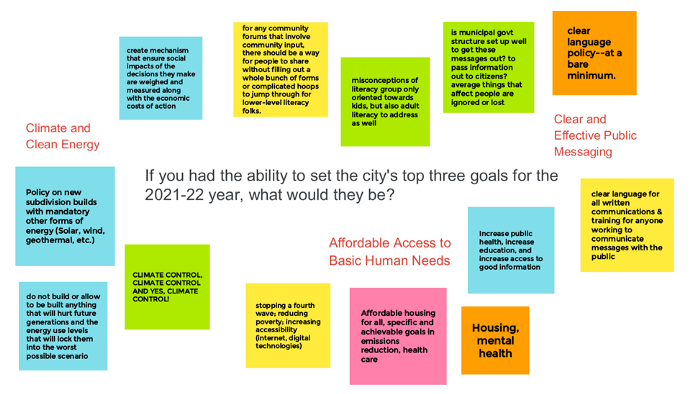Land Acknowledgement: The Waterloo Region smart city engagement session took place virtually, but engaged residents live on the lands of the Haudenosaunee, Anishnaabe, and Neutral Peoples.
On November 8, 2021, the Information and Communications Technology Council (ICTC) partnered with Evergreen Canada and Sustainable Waterloo Region to host ICTC’s seventh smart cities community engagement session. The Waterloo Region session was the most recent instalment of ICTC’s multi-year, smart cities research initiative, which engages residents and community leaders across Canada to better understand their community’s experience with smart cities. Each session begins with one or two presentations by local community groups and ends with a group discussion. During the discussion, attendees can identify what challenges and opportunities technology creates in their communities while sharing how technology impacts their lives. The information gathered during these sessions contributes to ICTC’s research and helps shape Canada’s smart city ecosystem.
The Waterloo Region engagement session was attended by 20 individuals from various backgrounds, including residents, members of the tech community, public servants, and advocacy organizations. It began with an introduction to ICTC’s multi-year research project and two presentations by local community groups. A summary of the community presentations is provided below, followed by an overview of the group discussion.

Photo by Crawford Passy on Unsplash
Community Presentation 1: Evergreen Canada
The first community presentation was led by Chelsea Carss, Senior Lead, Outreach and Partnerships with Evergreen Canada. Evergreen is a national not-for-profit that facilitates change at the community level through innovative partnerships. They collaborate across sectors to solve some of the most pressing issues cities face, such as climate change, housing affordability, and access to nature and public spaces. During her presentation, Chelsea spoke to the group about one of Evergreen’s core smart cities programs: the Community Solutions Network. The network provides expertise, guidance, and advisory services to municipalities and helps them build internal capacity to navigate the smart cities landscape. Figure 1 shows some of the activities that take place under the Community Solutions Network.
Community Presentation 2: Sustainable Waterloo Region
During the second community presentation, Tova Davidson, Executive Director of Sustainable Waterloo Region, spoke about smart cities from the perspective of climate change. Sustainable Waterloo Region is a local not-for-profit that helps the Waterloo Region and its local business community become more environmentally and economically sustainable. Their mission is to catalyze sustainable energy, mobility, and buildings systems to build a cleaner, more diverse economy. According to Tova, a “smart, sustainable city” is an innovative city that not only uses information communication technology (ICT) to improve quality of life, efficiency, and competitiveness but does so while meeting the economic, social, environmental, and cultural needs of present and future generations. Climate change is a direct and immediate threat to each city’s ability to meet these needs, making sustainability a core pillar of smart cities work. Tova also discussed some of the challenges Canada faces with respect to climate change: notably, Canada is warming twice as fast as the rest of the world and has the highest per capita emissions in the G20. Finally, Tova highlighted local sustainability initiatives like Climate Action Waterloo Region, which seeks to reduce local carbon emissions, coordinates the region’s Climate Action Plan, and engages community.
Group Discussion: Key Themes
ICTC led the engagement by working through a series of discussion questions with the participants. Participants were invited to participate in the discussion in writing via Google Jamboard, or by speaking out loud to one another on Zoom. The key themes that emerged in response to the discussion questions are summarized in the sections below. The engagement questions are listed in bold, followed by a summary of participant responses. Screenshots of some of the Jamboards used in the engagement are also included.
Questions 1 and 2: What comes to mind when you see the phrase “smart city?” When you think of a “smart Waterloo,” what is the first thing that comes to mind?
ICTC began the group discussion by asking participants what comes to mind when thinking of a “smart Waterloo.” This was done to get the participants general impressions or associations of local developments and challenges. Given the strength of the tech sector in the region, it was unsurprising that the larger tech community and technical skills development were highlighted. This included a sense that Waterloo Region was forward looking, with opportunities to use smart technology to reduce energy usage or further other sustainability goals. Participants also associated the term “smart Waterloo” with integrated data collection and the ability to access information quickly and easily, while improving quality of services.
However, participants also raised questions about which citizens or groups can participate in smart city discussions. It was noted that the outcome and contents of larger community discussions are innately determined by what questions are asked and who is consulted. Furthermore, there are issues of accessibility, which could range from insufficient internet access (for online consultations) to whether the language used in consultations is accessible to citizens with different levels of language proficiency. Similarly, tech access and language proficiency were key to the discussion of smart city services.
Finally, participants noted a significant challenge for Waterloo Region in the planning and delivery of smart cities: balancing the sometimes competing priorities and needs of a large, diverse region that encompasses both highly urban and highly rural areas. Regional diversity complicates smart city planning and delivery for Waterloo Region because the urban and rural areas can have very different needs and opinions on local community issues. Similarly, there are innate challenges in addressing the region’s immediate or short-term needs without losing sight of long-term planning. While it is necessary to meet citizens’ current needs and address current challenges (such as the COVID-19 pandemic), it can be difficult to maintain focus on long-term strategic issues in the region. These challenges are reflected in the following quotes:
“Smart cities need people to be able to see the future, and that’s the problem. It’s hard to see the future, especially for people that are impoverished, who are dealing with the here and now every single day… and, you know, it’s very middle class to be talking about smart Waterloo.” — Engagement Participant
“We do have these very insulated communities within the region that are not terribly well connected. They’re certainly better than when I was growing up, but each of them [is their own separate community]… and it makes it very difficult to get any kind of cohesion when you want to make big decisions that impact the entire community, like the big infrastructure changes that we’ve been talking about.” — Engagement Participant

Questions 3 and 4: What makes you the most optimistic about Waterloo’s immediate future? Have any new opportunities emerged for Waterloo over the last year?
When asked what they were most optimistic about, participants immediately pointed to a strong connection and sense of community between different stakeholders in Waterloo Region. According to participants, this sense of collaboration and community was even stronger during the pandemic. Local businesses pivoted quickly, championed civic engagement, were flexible in their service delivery, and took steps to make people feel comfortable. Not-for-profits stepped outside of their usual niches to provide new services and additional help where needed. Beyond the pandemic, community partners are committed to working collaboratively with one another to help solve local challenges. According to one participant, this sense of community, and the “clear and palpable intent to do community good,” makes some residents hopeful for the future.
Interestingly, participants felt that the pandemic made individuals and groups in Waterloo Region more open to change, opening up new digital possibilities for Waterloo Region’s future. These changes included:
- Employers are approaching employment with more flexibility, in response to an employer-driven workforce
- Businesses are trying out new hybrid business models that are partially in-person and partially online
- Community groups are seeing new opportunities to improve the virtual and digital skills of their staff
- Businesses and organizations that were “ahead of the game” in digital preparedness are recognizing that they can be mentors and help other organizations pivot
- Cities and city planners are starting to embrace holistic and systems thinking, which involves bringing diverse stakeholders into the planning process and is “required for change”
- Community groups that found new ways to engage during the pandemic are thinking of including these practices in their long-term programming


Question 5: What makes you the most concerned [when thinking of a “smart Waterloo”]?
When asked what concerns participants most, inequality was undoubtedly the main response. Inequality takes many forms, and participants from Waterloo Region indicated that they were concerned about financial inequality, health and mental health discrepancies, the digital divide, and access to education. Concerns about inequality were further reflected during the engagement’s final discussion question, where participants were asked to identify which goals they would set for the city for 2021–2022: for many participants, reducing inequality and making life more affordable for their fellow residents was important. In the context of smart cities, participants worried that digital and income inequality would create division in the community, separating residents into have and have-nots, and leaving those who are not technology savvy or cannot afford clean energy or other smart city solutions behind. Participants highlighted the need for municipal planning that is inclusive and takes into account the needs of all residents. This sentiment is reflected in the following quotes from the engagement:
“I think a lot of people just assume that everybody will be able to use technology if they have access to it, but it’s not true. Almost half our population would struggle with that. So, this is a real issue that if we don’t increase people’s basic skill levels — you’re never going to reach that smart city level.” — Engagement Participant
“The pandemic has really shone a light on how what we thought was a middle class, fairly educated population in Ontario has really struggled with the technological requirements to keep themselves safe.” — Engagement Participant
“Smart cities should be asking, ‘How can we allow people to seamlessly navigate public challenges?’ and not building a system that only 20 or 30 percent of the population can navigate. Navigation should not be a barrier to accessing what we’re trying to build.” — Engagement Participant

Question 6: If you had the ability to set the city’s top three goals for the 2021–22 year, what would they be?
When asked to identify what they would make the city’s top three goals for the 2021–2022 year, respondents stressed the need to meet “basic human needs” rather than flashy attention-grabbing projects. Key issues included public health measures, education, responding to the pandemic, addressing poverty, and increasing the accessibility of digital services, and housing. Providing residents with access to “good information” was also mentioned, perhaps in reference to public information campaigns and open data policies.
Climate change poses a clear and immediate threat to many municipalities, and in particular, their ability to meet the basic needs of their residents. As such, taking action against climate change and fostering investment in clean energy were central concerns among participants. Climate control and investing in alternative energy sources was mentioned both as a direct goal and a useful policy lens. Participants felt that climate and environmental impact was a lens through which all policy should be examined. One participant went as far as saying the region should “not build or allow [the building of] anything that will hurt future generations.”
Finally, respondents stressed a need for clarity in the communication of smart city of objectives from the Waterloo Region to residents. Three comments specifically addressed “clear language,” and the need to consider literacy levels among residents, those with lower literacy skills, those who spoke English as a second language, and/or those with a lower level of education; such people may feel left out or intimated by inaccessible, jargony language in municipal planning materials. Another comment stressed the importance of soliciting community input and the need to streamline feedback processes. Participants felt that residents should be able to provide feedback without the burden of “a whole bunch of forms and hoops to jump through.” Again, complex feedback processes risk intimidating or excluding citizens with limited time, resources, or literacy levels.

Closing Thoughts
During this community engagement event, ICTC gained significant insight on attitudes toward smart cities in the Waterloo Region. Some ideas such as the opportunity presented by new technologies to improve municipal services or reduce environmental impacts were shared by other Canadian municipalities, but there were also many unique local perspectives. For example, it was noted that the region encompasses both highly urbanized as well as rural areas, resulting in different and sometimes competing priorities. The discussion also highlighted the prominent role of not-for-profits and community organizations in addressing local challenges. While participants noted the strength of the innovative tech community, they also mentioned the need to address fundamental issues of affordability, livability, and accessibility.
One of the overarching themes that emerged was inclusivity and accessibility. Participants emphasized the need for smart city developments to acknowledge (and accommodate) very different levels of both fundamental literacy and digital literacy for community members. Unfortunately, many local citizens with low literacy levels are unable to fully participate in civic affairs. Participants felt that, at the city level, there is insufficient effort to accommodate these needs. Furthermore, participants emphasized the risk that smart city development could worsen inequality, particularly for marginalized groups.
The other key theme of these discussions was the importance of environmental sustainability. It was noted that there is a need to address immediate and future challenges regarding energy usage and climate change. This was tied to discussions of barriers to implementing smart city projects and the need to think long-term about these issues when investing in infrastructure.
The ongoing COVID-19 pandemic was also discussed throughout the engagement session. Unsurprisingly, participants noted the disruptions that the pandemic has caused, whether it be the impact on the local economy, increased poverty levels, or the growing importance of internet connectivity and digital skills. These complex and interrelated issues show the need to carefully consider how Waterloo Region can harness community partnerships and innovation to address these challenges. There is a need to both ensure the necessary services and support for all Waterloo Region citizens today, without losing perspective of present and future challenges of environmental sustainability.
